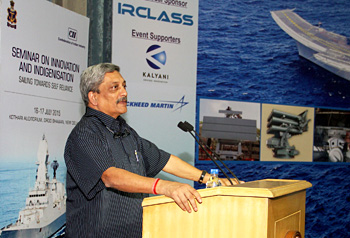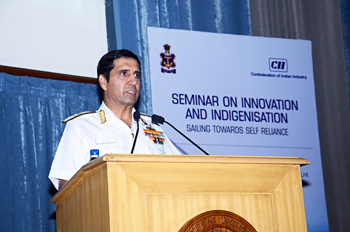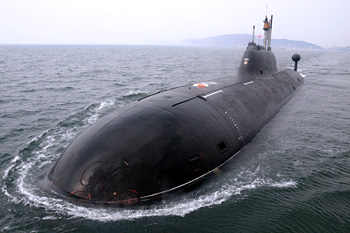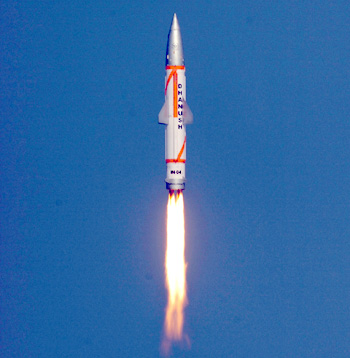INDIAN ARMED FORCES CHIEFS ON
OUR RELENTLESS AND FOCUSED PUBLISHING EFFORTS

SP Guide Publications puts forth a well compiled articulation of issues, pursuits and accomplishments of the Indian Army, over the years

I am confident that SP Guide Publications would continue to inform, inspire and influence.

My compliments to SP Guide Publications for informative and credible reportage on contemporary aerospace issues over the past six decades.
Indian Navy towards indigenisation
- 15 year indigenisation plan to open up opportunities for private sector
- Indian Navy plans to be 200-warship in by 2030
- Navy requires fully digitised integrated platforms




The Indian Navy has a good record of indigenisation compared to its other two sister arms — the Indian Army and the Indian Air Force. However, it is not up to the desirable level. Hence, the Indian Navy has been interacting with various industry bodies for inducting country-made equipment and systems on Indian naval platforms.
Consequent to the new government policy of encouraging gradual increase in the indigenised content in the naval systems, this year again on July 16 and 17 , the Indian Navy invited the Indian industry to produce locally, what the navy has been importing. For this the Indian navy organized a two day seminar with the Confederation of Indian Industries (CII) on “ Innovation and indigenization — sailing towards self reliance”.
Addressing the seminar the Chief of Naval Staff Admiral R K Dhowan said, “We have transformed from a buyer’s navy to a builder’s navy.” Currently, the Indian Navy has achieved maximum indigenisation in the float (hulls and vessels) category ( 90 per cent) and in the move propulsion ) category the level of indigenous content is roughly 60 per cent, whereas in the fight (weapon) category it is only 30 per cent . According to Admiral Dhowan, “there is a need to harness cutting edge technologies to increase the indigenisation content in the fight category.” Therefore, there exists huge opportunities for the industry to participate in the move and fight category. Obviously the weapons form the most technology sensitive component of the naval systems, which provide teeth to the naval platforms. Though Indian Defence Research and Development Organisation (DRDO) has succeeded in independently producing some weapon systems like the naval version of Prithvi missile called Dhanush and the supersonic ship based Brahmos cruise missile, the Indian Navy is critically dependent on foreign suppliers for its offensive capabilities.
Significant progress in electronic systems
In electronic systems, India has made significant progress in sonars, radars and communication systems. Still there is a long way to go. According to Admiral Dhowan,“it is possible to achieve 100 per cent indigenisation and to achieve this target by 2030 the Navy has formulated a 15 year indigenisation plan, which will be very soon shared with the industry bodies.” The Naval headquarters has also formulated a science and technology roadmap to look for technology of future programmes, with an aim of achieving 100 per cent indigenisation target in India. Admiral Dhowan said that the 15 year indigenisation plan for the Indian Navy will have a lot of opportunities for corporate India, which will generate additional jobs in the areas of services. This will have huge potential for the opening up of the private sector, which can be speeded up with public -private partnership.
The 15 year indigenisation plan is not a fresh one but refurbished from the earlier one which is under execution since 2007-08 which would have run till 2022, but in view of some recent developments the navy will be coming out with fresh revised programme for 2015-30. Along with the science and technology roadmap the navy is also working on the maritime technology plan. Indian naval and civilian shipyards are already overflowing with orders, hence the Indian private sector has immediate opportunities waiting for them as the Navy plans to be 200 warship strong in the next 15 years, which currently has only 137 warships. The aviation assets of the Indian Navy are to be increased almost three times to over 600 aircraft both fixed and rotary wing .
With such ambitious expansion plans, the focus for the Navy is to ensure that all ships are made in India. This will fulfill the ambitious programme of ‘Make In India’ propounded by the Prime Minister Narendra Modi. Many new shipyards in the private sector have emerged, which promise to fulfill these ambitious targets, for which many highly advanced ship making countries like South Korea and Russia have already expressed their wish to collaborate . The most recent case is that of Anil Ambani- owned Pipapav shipyard signing a cooperation agreement with a Russian shipyard. The Pipavav shipyard is expected to manufacture three Grigorivich class Russian frigates, which will be worth billions of dollars. The Chairman of the Reliance Group Anil Ambani said during the seminar that “defence manufacturing sector has witnessed paradigm shift and there is a need for everyone to channelize their energies towards self reliance.” The Defence Minister Manohar Parrikar advised the armed forces to treat the Indian industry as partner rather than as a vendor or supplier. “Mutual trust between the Indian Navy and industry is must for achieving high level of self reliance without compromising on transparency.”
Multi-dimensional force
The Indian Navy which had only 33 ships in 1947 is today a multi-dimensional force with latest capabilities in surface, subsurface, air space and cyber domain. Now the Indian Navy is engaged in future technology roadmap. The present warships of Indian Navy has gas turbine technology of seventies, which is to be upgraded now. The Navy now requires fully digitized integrated platform management with diverse spectrum of technology which has to be synergized for effective dominance of the surface, subsurface and air space. The Indian Navy is also working on a technology perspective capability roadmap which is being finalized for future requirements and capabilities. According to Indian Navy officials, in the short term the Navy needs indigenous phased array surveillance radars, fire control systems, kinetic energy systems, next generation seekers etc. To achieve all this, India also needs to invest in research and development for miniaturization of the systems. Considering all these indigenous requirements, the Indian Navy promises a period of sustained growth for Indian defence industry. These will have to be supplemented by modern net- centric capability, unmanned and remotely operated vehicles. The challenge for the Navy is to provide future propulsion systems.
Indigenisation is the long term solution to ensure operational readiness and competiveness on the high seas for which the Navy needs highly indigenous content of technology, systems and equipment. For this the Indian industry feels that increasing FDI (foreign direct investment) in defence should be encouraged with simplification of buy and make procedures. This also requires partnership between industry, DRDO and the academia.
The Indian Navy has been a pioneer in indigenisation with 138 ships and submarines made in Indian shipyards. It is to the credit of Indian shipyards that it is now making the most advanced naval platform in India - aircraft carrier Vikrant, which will make India the sixth nation in the world to produce such highly complex warship. It will be inducted in the Indian Navy by 2018. Presently, 48 warships and submarines are on orderwith Indian shipyards and in the near future 44 more warships and six submarines are planned to be made in Indian shipyards.
Need to create shipbuilding eco sytesm
Indian industry representatives are of the view that India needs a shipbuilding policy and shipbuilding ecosystem, which at present India woefully lacks. There is a need to treat shipbuilding industry as strategic industry , as South Korea has set an example before the world. Presently, the Indian Navy has an ageing fleet. To replace this the Indian Navy has placed orders worth 1,70,000 crores before various Indian shipyards and by 2023 the naval projection is that of Rs 3,30,000 crores. By 2027 the order before Indian shipyards would be worth Rs 4,57,000 crores. Thus the Indian shipyards have on average 56,000 crores annual orders out of which Rs 25,000 crores per year would be available for the private sector. To enable Indian shipyards to be ready to bag these huge possibilities a policy framework is urgently required.
The Indian Navy Directorate of Naval Design is the repository of all design data of Indian ships and if provided more resources it can design more futuristic ships for the Navy. . The Indian private sector can in fact depend DND for advanced indigenous design of the ships. Experts say that indigenous shipbuilding should be considered a tool for strategic maritime cooperation in the Indian Ocean region. Over 90 per cent of Indian trade passes through maritime highways, hence India needs big indigenous shipping industry. Shipbuilding reflects the overall national power of the country. The defence and civilian shipyards can in fact supplement each other’s capabilities and resources to develop a strong shipbuilding industry, which would prove to be a great strategic asset for the country. . India can offer warship and commercial ship retrofitting services to the coastal states of Indian Ocean. According to a naval official India needs to pursue a drydock diplomacy to advance India’s strategic interests and strengthen shipbuilding industry in the country.





